Located in the southeast, Virginia spans 42,774 square miles and is bordered by seven other states and the Atlantic Ocean. Virginia is well-known for the stunning Chesapeake Bay and Shenandoah Valley. However, it is also known for its animals and snakes are particularly abundant in the state. There are 32 different species, including three that are venomous. Although snakes can be a wide variety of colors and patterns, a lot of them are brown, which helps them to blend in with their surroundings. It’s a good idea to know where they live and be able to identify them. So, let’s discover the brown snakes in Virginia!
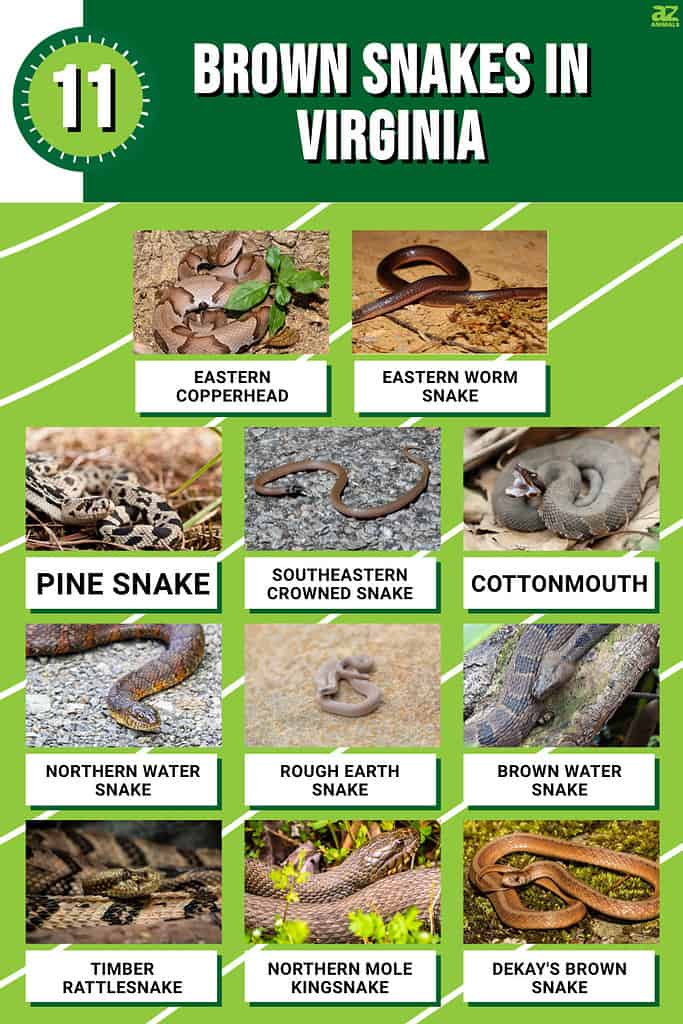
1. Eastern Copperhead (Agkistrodon contortrix)

They have pale to pinkish brown bodies which are overlaid with darker brown hourglass-shaped markings that often have lighter-colored centers.
©Jeff W. Jarrett/Shutterstock.com
We’ll begin with the first of the three venomous snakes in the state — the eastern copperhead. Copperheads are typically 20 to 37 inches long. They have pale to pinkish brown bodies which are overlaid with darker brown hourglass-shaped markings that often have lighter-colored centers. Copperheads are widespread across Virginia and mainly live in mixed forests and woodlands where there are plenty of rocks and logs for them to use as shelters. They are pit vipers but actually have some of the mildest venom. They also tend to employ a “warning bite” first, whereby they bite without injecting any venom.
2. Eastern Worm Snake (Carphophis amoenus amoenus)
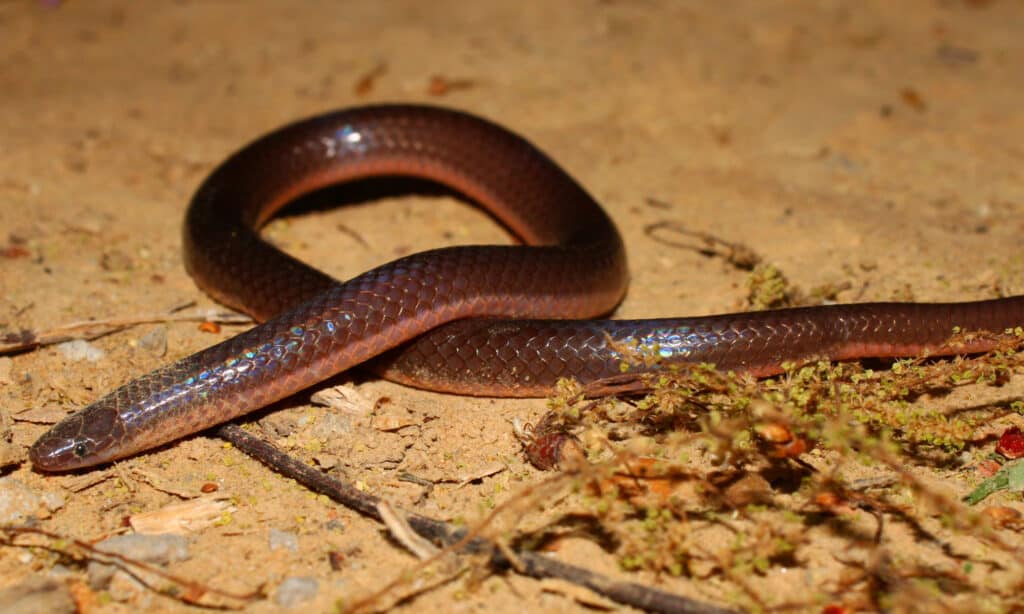
These snakes have glossy brown bodies with smooth scales. They are very small and reach a maximum length of just 13 inches.
©Jason Patrick Ross/Shutterstock.com
From a venomous snake we now move onto a harmless brown snake in Virginia — the eastern worm snake. The eastern worm snake is a subspecies of the worm snake and preys predominantly on earthworms. Although they do not bite, they do sometimes produce a foul-smelling musk when handled. These snakes have glossy brown bodies with smooth scales. They are very small and reach a maximum length of just 13 inches. Eastern worm snakes live in woodlands and are primarily burrowers, spending most of their lives hidden away underneath logs and rocks or buried in the leaf litter. They can be found across Virginia, with the exception of a few counties in the far southwest region.
3. Pine Snake (Pituophis melanoleucus)
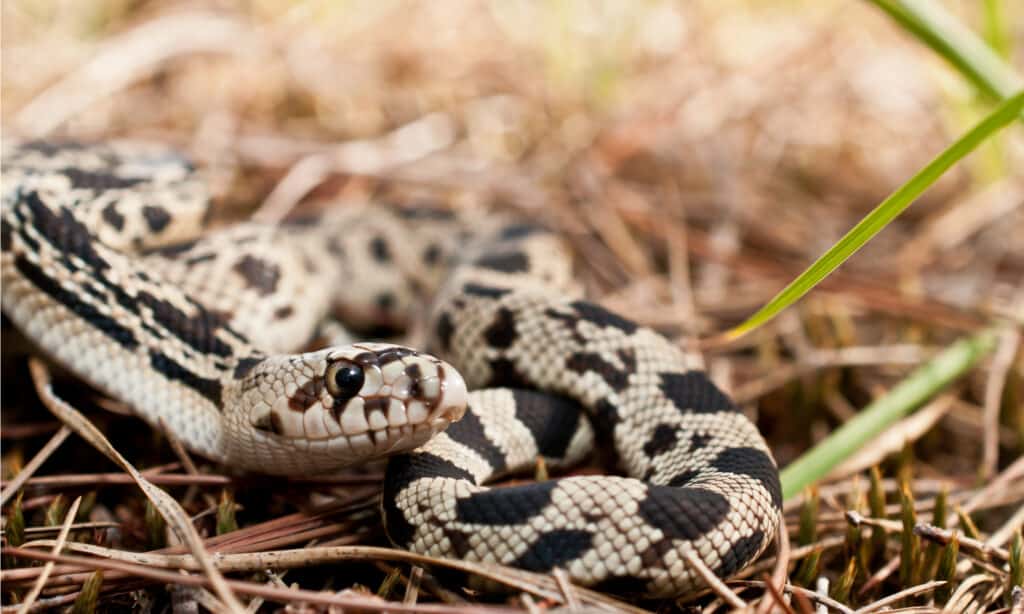
Northern pine snakes only live in Augusta, Bath, Botetourt, and Craig counties where they prefer sandy regions and dry forests.
©Jay Ondreicka/Shutterstock.com
One of the largest snakes on the list is the pine snake which is 48 to 90 inches long and is light brown with black markings. Pine snakes are not venomous. However, they mimic venomous snakes by flattening their neck and hissing, while vibrating their tail. They will do this when disturbed, before eventually striking out at the threat. Pine snakes mainly prey on rodents and are known to enter burrows and make multiple kills. There are three subspecies of pine snakes, and the northern pine snake is the species that can be found in Virginia. However, they only live in Augusta, Bath, Botetourt, and Craig counties where they prefer sandy regions and dry forests.
4. Southeastern Crowned Snake (Tantilla coronata)

Southeastern crowned snakes are light brown with black heads and usually have a band of yellow.
©John Sullivan / CC BY-SA 3.0 – License
One of the smallest brown snakes in Virginia is the southeastern crowned snake which is only 8 to 10 inches long. Southeastern crowned snakes are light brown with black heads and usually have a band of yellow or cream between their head and neck. They are secretive snakes and prefer to live in woodland habitats with plenty of loose, sandy soil and leaf litter for them to hide in. They are endemic to the southeastern region of the US but mainly only occur in the southern region of Virginia. Although they are small and pose no threat to humans, southeastern crowned snakes are mildly venomous to their prey. They possess a small set of rear fangs with which they inject venom into their prey. However, they only prey on small animals such as centipedes, spiders, and worms.
5. Cottonmouth (Agkistrodon piscivorus)
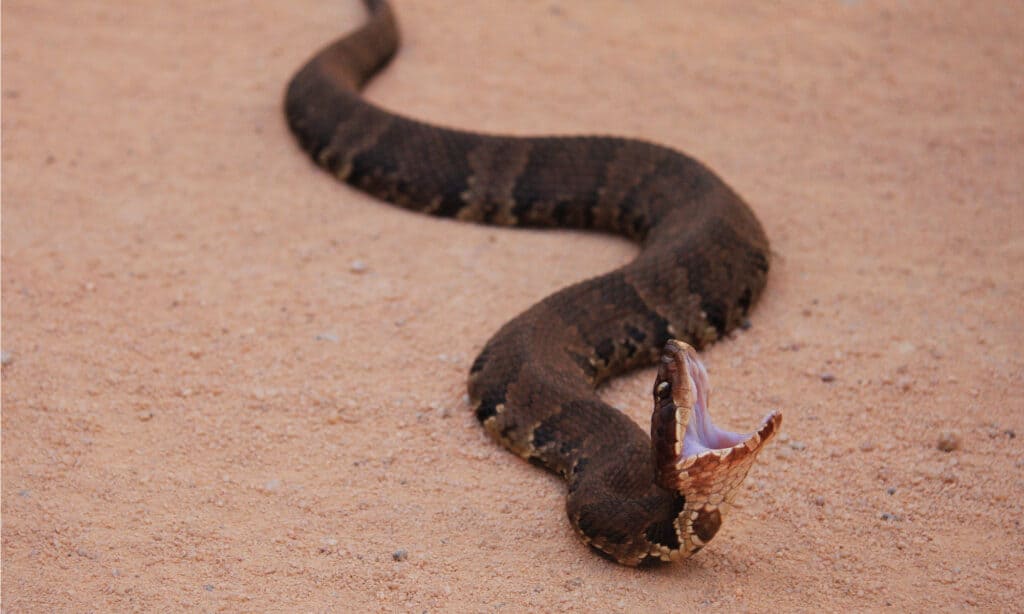
Cottonmouths are highly venomous and contain cytotoxic venom which destroys tissue, leading to extensive scarring and even amputation.
©Nathan A Shepard/Shutterstock.com
The next venomous snake is the cottonmouth, which is a semi-aquatic pit viper. Cottonmouths are typically 30 to 43 inches long and have dark brown bodies which are overlaid with a series of dark brown to black crossband markings. However, their most distinctive feature is the white lining on the inside of their mouth, which looks like cotton — hence their name. Cottonmouths can live in any freshwater habitat but are only found in the far southeastern corner of Virginia. Most populations in the state live south of the James River and are most abundant in the Chesapeake and Virginia Beach areas. They are highly venomous and contain cytotoxic venom which destroys tissue, leading to extensive scarring and sometimes even amputation.
6. Northern Water Snake (Nerodia sipedon)
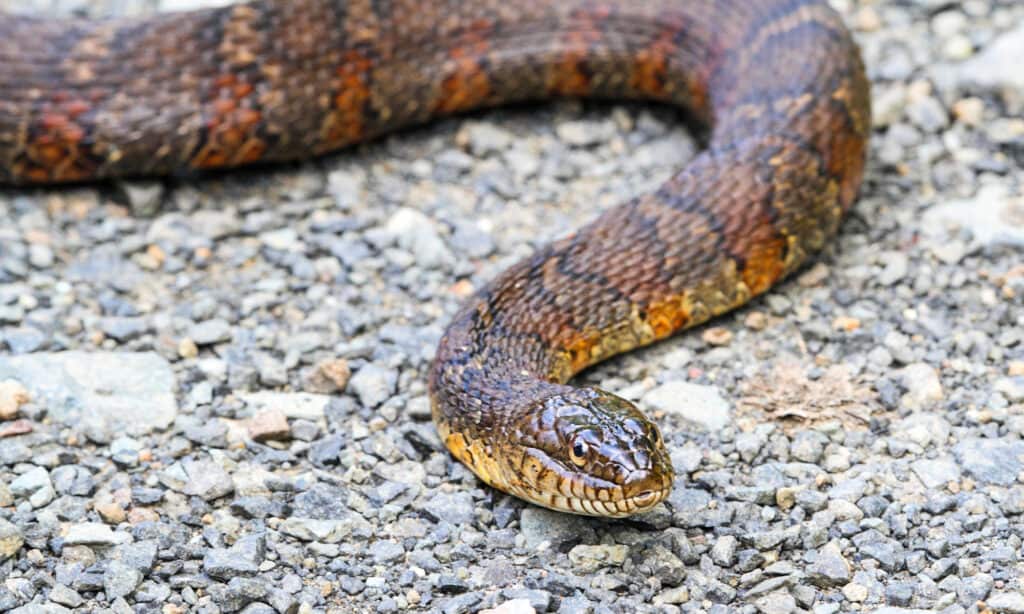
Northern water snakes are 56 inches long and are dark brown with a series of blackish crossband markings and blotches.
©Steve Byland/Shutterstock.com
The northern water snake is one of several water snakes in Virginia and is found statewide in virtually every freshwater wetland habitat. Northern water snakes are 56 inches long and are dark brown with a series of blackish crossband markings and blotches. They have a very similar appearance to the cottonmouth, which sometimes leads to them being killed by people who misidentified them as a venomous snake. Northern water snakes are not venomous, but they can be highly aggressive if they are disturbed and regularly strike out at threats. Their saliva contains a mild anti-coagulant which means that any wound they inflict will bleed a lot.
7. Rough Earth Snake (Haldea striatula)

Rough earth snakes prefer areas where they can burrow into the soil or the leaf litter.
©Creeping Things/Shutterstock.com
The next brown snake in Virginia is the rough earth snake, which is very similar to the smooth earth snake but has keeled (ridged) dorsal scales. They are 7 to 10 inches long and have thin brown bodies. Rough earth snakes occur in scattered locations in the southeastern region of the state and live in urban areas as well as forest regions. However, they prefer areas where they can burrow into the soil or the leaf litter. They are completely harmless to humans and eat only small prey such as earthworms. When threatened, they release a strong-smelling musk and defecate to try and make themselves less appetizing to predators.
8. Brown Water Snake (Nerodia taxispilota)
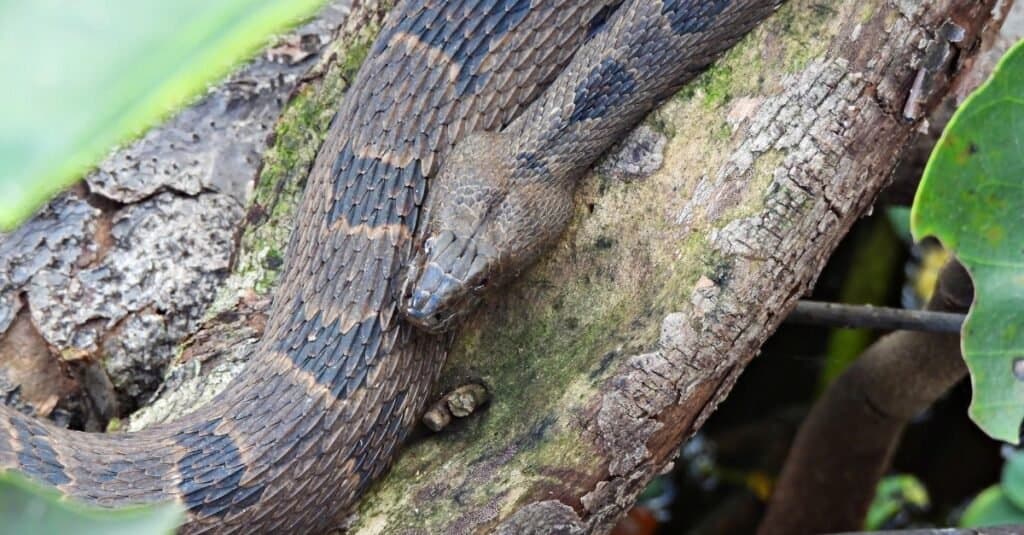
Brown water snakes mainly live in streams and swamps and only occur in the southeastern region of the state.
©iStock.com/passion4nature
Another water snake is the brown water snake, which is 30 to 60 inches long. Brown water snakes are brown with approximately 25 dark brown or black markings along their back. They are notable for having a head that is much narrower than their neck, despite their large body. Brown water snakes mainly live in streams and swamps and only occur in the southeastern region of the Virginia. They mainly prey on juvenile catfish and are not venomous. However, they are often mistaken for the cottonmouth and can react aggressively when they are threatened.
9. Timber Rattlesnake (Crotalus horridus)
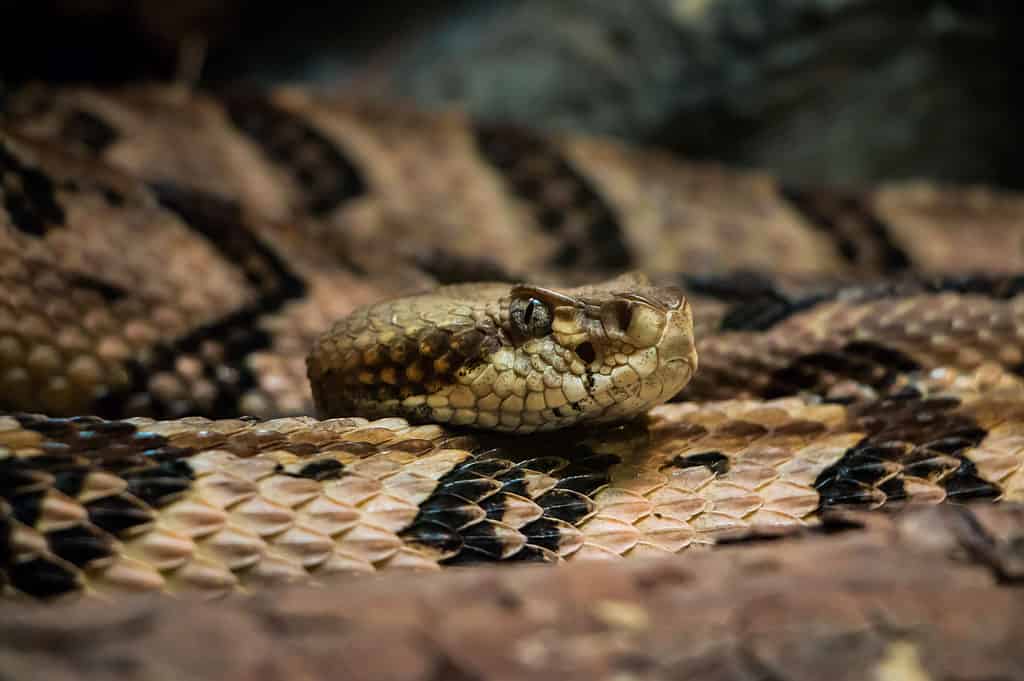
Timber
rattlesnakes
are one of the most dangerous snakes in North America and have large fangs and a high yield of neurotoxic venom.
©Dennis Riabchenko/Shutterstock.com
Another venomous brown snake in Virginia is the timber rattlesnake, which occurs mainly in the western region of the state, with the exception of a population in the far southeastern corner. They can mainly be found in mountainous forests where females can be seen basking on rocky ledges known as “basking knolls”. Timber rattlesnakes are large snakes with lengths of between 36 and 60 inches. They have heavy brown bodies with dark brown or black crossband markings. Timber rattlesnakes are one of the most dangerous snakes in North America and have large fangs and a high yield of neurotoxic venom. However, they have a relatively mild temperament and do a lot of feinting before actually striking.
10. Northern Mole Kingsnake (Lampropeltis rhombomaculata)

Northern mole kingsnakes are not venomous and prey predominantly on rodents.
©Krumpelman Photography/Shutterstock.com
Also known as the brown kingsnake, the northern mole kingsnake is 30 to 40 inches long and is typically light brown with dark or reddish-brown blotches. They mainly live near forest edges and occur across the majority of Virginia’s eastern and central regions. However, they are absent from counties on the east coast. Northern mole kingsnakes are not venomous and prey predominantly on rodents. However, when they are threatened, they often vibrate their tail which can mimic the sound of a rattlesnake.
11. Dekay’s Brown Snake (Storeria dekayi)
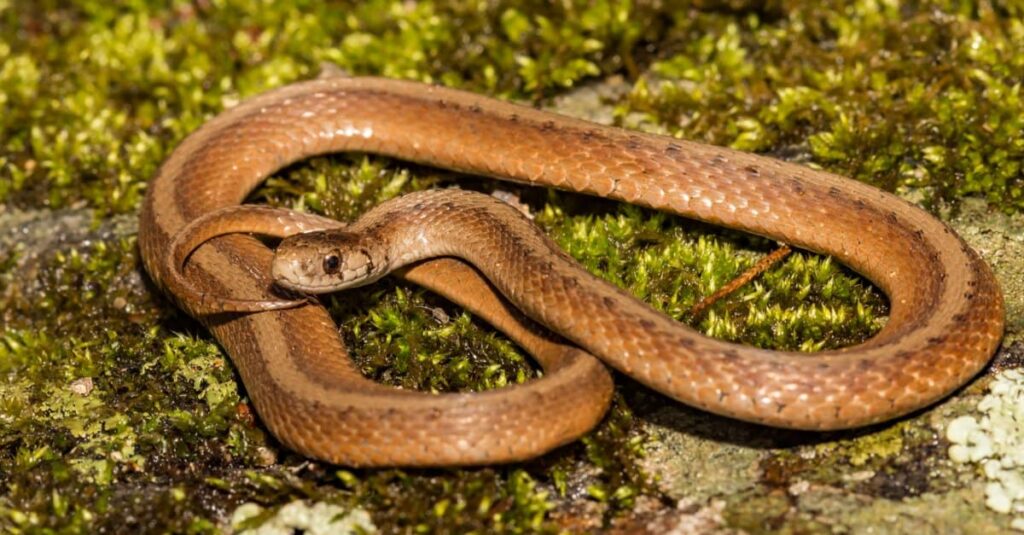
These snakes are only 9 to 13 inches long and have thin, light brown bodies with a faint stripe down their back.
©Jay Ondreicka/Shutterstock.com
The final brown snake in Virginia is another small, harmless variety — Dekay’s brown snake. These snakes are only 9 to 13 inches long and have thin, light brown bodies with a faint stripe down their back and small black spots on either side. Dekay’s brown snakes are widespread across most of the state but are more abundant in the eastern region. They prefer to live in wetland and terrestrial habitats but are secretive and like to remain hidden in the leaf litter or beneath rocks and logs. They are mostly nocturnal and prey on small animals such as earthworms and slugs.
Summary of 11 Brown Snakes in Virginia
| Snake | Scientific Name | |
|---|---|---|
| 1 | Eastern Copperhead | (Agkistrodon contortrix) |
| 2 | Eastern Worm Snake | (Carphophis amoenus amoenus) |
| 3 | Pine Snake | (Pituophis melanoleucus) |
| 4 | Southeastern Crowned Snake | (Tantilla coronata) |
| 5 | Cottonmouth | (Agkistrodon piscivorus) |
| 6 | Northern Water Snake | (Nerodia sipedon) |
| 7 | Rough Earth Snake | (Haldea striatula) |
| 8 | Brown Water Snake | (Nerodia taxispilota) |
| 9 | Timber Rattlesnake | (Crotalus horridus) |
| 10 | Northern Mole Kingsnake | (Lampropeltis rhombomaculata) |
| 11 | Dekay’s Brown Snake | (Storeria dekayi) |
The photo featured at the top of this post is © Steve Byland/Shutterstock.com
Discover the "Monster" Snake 5X Bigger than an Anaconda
Every day A-Z Animals sends out some of the most incredible facts in the world from our free newsletter. Want to discover the 10 most beautiful snakes in the world, a "snake island" where you're never more than 3 feet from danger, or a "monster" snake 5X larger than an anaconda? Then sign up right now and you'll start receiving our daily newsletter absolutely free.
Thank you for reading! Have some feedback for us? Contact the AZ Animals editorial team.






